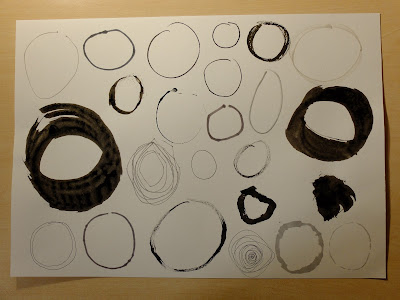Initial Studio Task - SINK
The first task had my head in a spin, and really demanded deeper thinking, in an attempt to represent the word in interesting and perhaps more subtle ways. Looking back at this sheet I don't think my ideas were terrible...perhaps just badly drawn? The ideas are one thing, but then translating them onto a page without reference?! tricky stuff. The small frames were also an added challenge, trying to simplify each image right down to work within the tiny space.
This is a task I should retry and attempt to pull off better. I really learnt the struggle of translating written word into visual imagery that is thought provoking and interesting, and that I find that struggle very apparent...
Internet Trolls Beware
With an article about technology, I really wanted to sway away from the most obvious responses, that being images of phones or computers, despite 2 of my 3 finals containing exactly that; I should probably learn to stick to my initial intentions throughout each project. I also struggled to not be figurative with my responses and it became very apparent with my first few roughs that was a direction I was heading in. I think my brain might just work that way though, initially at least. I think it is an important skill to learn to think in different ways other than figuratively. Perhaps it is because images of people are so familiar and recognisable and relatable that causes them to immediately spring to mind, or maybe a lot of the work I like contains human forms? who knows, but it's something I am conscious of.
A few reasons why my rejected roughs didn't work:
- Too complex; the scenes containing several people were just not accomplished or refined enough to be clear and meaningful, instead they ended up busy and confusing. Plus they were too typical and bland,
- Misleading; some just sent the wrong messages about the piece, hinting at concepts and themes totally unrelated, mistakingly included in trying to portray a relevant message. I perhaps didn't consider every side to the article in these, or perhaps honed in on one side with no consideration for the overall theme,
- Wrong tone of voice; the article's tone was portraying the change in legislation as a positive thing to protect internet users, whereas some of the roughs suggested a totally opposing opinion, focussing more on the loss of freedom of speech as opposed to the positive safety aspect gained from the changes. I think to combat this I need to decide a view point on the article, or portrayed by the article, and constantly cross reference them with the work I am making to ensure that they align with each other.
I wrestled with a multitude of ideas and concepts and images within my roughs for quite a lot time and produced quite a lot of different ones. It was interesting then, that for my 3 finals, I chose to develop some of my earlier roughs...perhaps the best ideas happen early on? and the rest are just brain workings that need to just be put down on the page to free them? And perhaps when compared, they make the earlier roughs look half decent?
In this way, maybe my finals were just the best of the worst? I wasn't overly happy with any of them, for their imagery or concepts as a whole. I am pleased with some of the images I created, such as the representation of bubble wrap using rolled out ink and a pen lid as a stamp. I am also pleased with the buffalo as a drawing, the combination of loose tip-ex marks and finer pen lines; they have a certain energy about them.
Things to Work on:
- Use of 'real estate' and composition, using the space available in a more effective and useful manner,
- Keeping ideas and images simple and to the point, but clever and effective in their purpose,
- Thinking more deeply and imaginatively about how to communicate and represent ideas, themes and concepts visually.

Chris Niemann
 After looking at some of Niemann's work I was inspired to try and incorporate 3D objects into my drawings, similar to how he does in his, to create an interesting relationship between object and line.
After looking at some of Niemann's work I was inspired to try and incorporate 3D objects into my drawings, similar to how he does in his, to create an interesting relationship between object and line.I wish I had drawn the face better but it's an interesting concept, to see objects as not only reference material, but direct source material in image making. Especially when the object itself has a specific and thought out purpose and link to the concept.
























